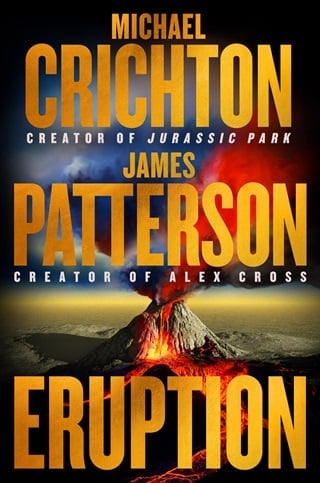Chapter 15
Kīlauea Rim, Hawai‘i
Time to eruption: 110 hours
MacGregor pulled into the carport of his house on Crater Rim Drive, behind the tourist facility at Volcano House. There were six National Park Service houses on Crater Rim Drive, all rented by HVO staff. When he got out of his car, he heard the shouts of Rick Ozaki's kids playing on the lawn in front of the brightly lit house down the road.
His own house was dark and silent. He went inside, turned on the lights, and walked into the kitchen. Brenda, his housekeeper, had left him a bowl of saimin—Hawaiian noodle soup—for supper. He clicked on the TV. It had been nearly a year since Linda moved back to the mainland, and he kept promising himself he would move out of the home they'd shared. It wasn't that large, but it still held too many memories. He glanced into the twins' bedroom, which he hadn't changed since their departure. For a while, he'd kept thinking they would come back, but they never did. They were eight now. Second grade. Charlie and Max.
They should have been outside making as much noise as Rick's kids were.
He'd come home early one afternoon and found the twins sitting in the living room dressed in their good clothes and Linda packing in the bedroom. She said she was sorry, but she couldn't take it anymore: the constant rainy weather, the isolation up on the mountain, the absence of her friends and family. She said that MacGregor had his work and it was fine for him to go around the world to strange places chasing volcanoes, but she was a lawyer and she couldn't practice here in Hawai‘i, couldn't do anything here; she was going crazy being only a mother, and she had tickets for the five o'clock plane to Honolulu.
She said the boys didn't know yet—they thought they were going on a quick trip to see Grandma.
He said, incredulous, "Were you just going to leave without telling me?"
"I was going to call you at the office."
"And then, what, send me a Hallmark card?"
"Please don't make this any more difficult than it already is."
"Of course not," he said. "I wouldn't want to upset you."
They were only a few feet apart, but the distance that she was about to put between them existed already.
"So you weren't even going to let me say goodbye to the boys?"
"I didn't want you to upset them."
Somehow, he managed not to lose his temper. There was no point in arguing with her or trying to change her mind. They both knew this had been coming for a long time, but they had no way to prevent it. Even though he'd given up his place on the USGS advisory team when he married her, they still moved every few years. He'd been in Vancouver for two years, then Hawai‘i for five years, and he'd be leaving here next year. But Linda wanted to practice law, and for that she needed to move to a city and stay there so she could build a practice.
When they'd first married, none of this seemed important. She'd talked about doing pro bono work, said his travel didn't matter. But of course it did matter. For his part, MacGregor had said he was willing to take a university position and settle down. But of course he wasn't. He was a research volcanologist by training and temperament. That meant being in the field. He felt good only when he was in the field. He got restless if he spent too much time indoors. It was one of the reasons the guys in the data room called him a cowboy.
There had been a time after the twins were born when they might have worked it all out, made the necessary compromises. But they'd waited too long, had become more and more removed from each other.
That day, he had watched her pack for a while, and then he'd gone to hug the boys and—
The screen door slammed behind him, jolting him out of his thoughts.
"Are you trying to torture yourself? What's next, you take out the home movies?"
It was Jenny. She'd caught him standing in the doorway to the boys' room, saw him blinking back tears as he turned around.
She said, "I thought you were going to move out."
"I am."
"When, the twelfth of never?" She headed toward the kitchen. "I brought you the checklist for all the extra personnel we're going to need in case you want to go over that tonight. Last big eruption, they had forty extra park rangers. We'll need at least that many, and we'd better requisition them. And extra police, Hilo and Kona, for additional traffic control. And we need to set up an infirmary with a full-time doc, paramedics, and a standby ambulance… there's a lot to arrange."
Despite himself, he smiled. This was Jenny being Jenny.
He followed her into the kitchen. "Want some saimin?" he asked, putting it in the microwave.
She wrinkled her nose. Despite being a Honolulu native, Jenny didn't like the local food. "Got any yogurt?"
"I think so." He opened the refrigerator. "Strawberry?"
She looked at him suspiciously. "Don't take this the wrong way, but how old is it?"
"Not that old." He managed a smile. "And is there any other way for me to take a question like that?"
He got the yogurt out of the refrigerator, fished in a drawer for a spoon.
"What's this?" Jenny said, pointing to the blue folder on the kitchen table.
"Some old Defense Department study that Rick and Kenny dug up and wanted me to look at."
"‘Vulcan,'" she read aloud, sitting down. "The Roman god of fire."
The microwave beeped and he removed the steaming bowl of noodles. He sat down at the table and, with chopsticks, picked out the floating pieces of Spam and set them aside on a plate. The dirty little secret about island saimin was that it was made with Spam, and although MacGregor had told his housekeeper multiple times that he didn't like it, she kept using it.
Jenny thumbed quickly through the folder. She paused and frowned, then turned the pages more slowly.
MacGregor asked, "What is it?"
"Mac, have you read this?"
"No."
"What's vent deflection?"
He shook his head. "Never heard of it."
"Well, this whole report is about vent deflection." She flipped back to the first page. "Here it is… Project Vulcan and mechanisms of vent deflection."
MacGregor got up and read over her shoulder.
PROJECT VULCAN (VENT DEFLECTION) BACKGROUND TO PROJECT
In response to the threat of a potentially disastrous eruption of Mauna Loa following the July 1975 eruption, local authorities requested that federal military agencies prepare contingency plans for lava diversion. Four methods to divert lava were investigated: dikes, seawater application, bombing, and vent deflection.
Dikes have invariably failed in the past. Even when they are notably strong and high, i.e., 25 to 40 feet (8 to 12 meters), they are overrun.
Seawater cooling has succeeded only in Iceland; there, the lava flowed near the sea, so pumping was manageable. In Hawai‘i, pumping seawater up a 13,000-foot mountain is not practical.
Bombing was carried out in 1935 and in 1942, with questionable results. In 1935, the lava was already halting of its own accord and most observers felt bombing had no effect. In 1942, bombing clearly failed to halt the lava.
"We know all this already," MacGregor said.
"Yes," she said, "but did you know the army ran bombing tests back in the seventies?" She turned the page, kept reading.
To acquire detailed information on direct bombing effects, in 1976 the U.S. Army conducted tests on the north slope using 2,000-pound (900-kilogram) MK-84 bombs. This ordnance produced craters 10 meters wide and 1.8 meters deep, which were deemed too small to divert flows. Attempts to break open lava tubes failed. The 1976 tests suggest that aerial bombing will never succeed and should be abandoned.
Vent deflection remains the only possible method for control of lava flows. Procedures to accomplish this are limited by a lack of knowledge of subsurface geography and magma flows prior to eruption. However, such data may be available in the future. This report considers three potential methods of vent deflection that may be employed in the future.
"It seems," Jenny said, "they're talking about placing explosives around a potential vent to control its behavior."
In a modified form, the idea wasn't entirely new. A bombing contingency plan had been drafted ahead of Mauna Loa's 1984 eruption but never used. Since lava seemed to be unstoppable once it got going, there had been a lot of discussion about trying to modify the vents—the openings through which lava appeared on the slopes. Some scientists believed that you could bomb the vents and divert the lava right at the mouth.
But this was different. It was more like the technique used in 1992 during the eruption of Italy's Mount Etna, when engineers detonated eight tons of explosives to expand a channel for flowing lava and save a village in its path. This report suggested that a vent could be opened at will and that the eruption could be directed, could be controlled…
MacGregor leafed through the report and saw page after page of dense calculations—explosive zone effects, shock-wave propagation in basalt, target conduit expansion rates.
He nodded in genuine admiration. "They really went into this."
"Looks like it," Jenny said. She turned to a series of detailed maps of the caldera and the rift zones where placements for explosives had been marked. There were also ground photographs of proposed rift-zone sites.
MacGregor's eyes settled on one paragraph.
Current tunneling technology (TK-17, TK-19, etc.) permits the drilling of narrow cores (less than one meter in diameter) to a depth of four kilometers beneath the surface, deeper if significant thermal effects are not encountered. On an emergency basis such cores can be drilled in 30 to 50 hours. The effect of appropriate ordnance in narrow cores has been studied previously (cf. Project Deep Star, Project Andiron). Furthermore, the recent success of precise detonation timing (PDT) suggests that the resonant-shock phenomenon (RSP) will greatly amplify any ordnance effect within a core.
"So this is what the boys were talking about," MacGregor said, frowning. "But I don't get it. I mean, I get that somebody spent a lot of money to do this study. I'm just not sure why."
Jenny shrugged. "DARPA does cutting-edge projects. They started developing the internet back in the 1960s, remember?"
"Ah, our tax dollars at work."
"Local officials must have asked for this," Jenny said.
"True," MacGregor said, "but back then, Hilo was a town of—what? Thirty-five thousand? That doesn't justify a study costing a couple of million dollars. It still doesn't make sense to me."
"Could be strictly political," Jenny said. "So many studies for Hawai‘i, so many studies for California and Oregon. Like that."
"Maybe."
"Didn't HVO get some funding from this?"
"Not sure. I'd have to check." He drummed his fingers on the table. "There's something we don't know." Still frowning, he flipped to the last page, the summary.
SUCCESS PROBABILITIES
Estimation of success for Project Vulcan is difficult given the degree of uncertainty surrounding major project variables. These cannot be weighted in the absence of an actual eruption. A succession of simulations using the STATSYL program for statistical analysis suggests a likelihood of success ranging from 7 percent to 11 percent.
However, based on the past 200 years of eruptions, the likelihood that lava will reach any given site is a function of distance from the eruptive region and is, on average, 9.3 percent. This suggests that Vulcan's likelihood of success is no greater than chance—that is, it is entirely ineffective. In the absence of further technological advances, we recommend that attempts at vent deflection be abandoned.
We conclude that the only practical method to protect populations from flowing lava is to evacuate them before its advance.
MacGregor laughed.
"What is it?" Jenny said.
"Our boys didn't give away the ending."
"What are you talking about?"
"They didn't tell me that the report concluded it wouldn't work."
"But they think it can?"
"It's like they're trying to talk themselves into it," he said. "And talk me into it."
"Have they?"
He grinned. "Have you ever seen them talk me into anything?"
"Always a first time," Jenny said. She kissed him on the cheek quickly and left.
Mac spent an hour or so researching dikes and seawater cooling, trying to get to where Rick and Kenny wanted him to be. Surprisingly, the most compelling argument came from J. P. Brett, billionaire tech guy, in a long op-ed piece in the Los Angeles Times. Brett, Mac knew, was as obsessed with volcanoes as other rich billionaire types were with space travel. Rockets were rich-guy phallic symbols.
But Brett knew his stuff. One of the events he referenced was the 1973 eruption of Eldfell in the Vestmannaeyjar archipelago in Iceland. Brett focused on seawater pumped in to cool the lava and a twenty-five-meter-high artificial dike built at the end of the lava tongue. A handful of scientists believed that pumping in seawater would significantly slow the lava and stop it from flowing into the town, but only if extremely powerful pumps were used and only if that equipment was there within one week. The pumping equipment was delivered, but not until two weeks later. As for the dike, although the lava traveled slowly at first, by the time it reached the dike, it was more than twice its height and easily overtopped it. After the fact, scientists concluded that even if the seawater pumping equipment had been brought in much sooner, it still would not have stopped the powerful lava flow or saved the town.
Brett disagreed. Vehemently. He noted that now, half a century later, friends of his could build their own rockets, so Brett was certain that one of his companies could produce sophisticated and powerful pumping equipment and build a dike that would survive a nuclear attack.
Mac sat in the quiet of his den and reread the article, then printed it out. Now he would have that drink. "Well, I'll be damned," he said, raising his glass in a toast to the boys. "Maybe they can talk me into this."
But he sure wasn't going to make it easy for them.
 Fullepub
Fullepub 



